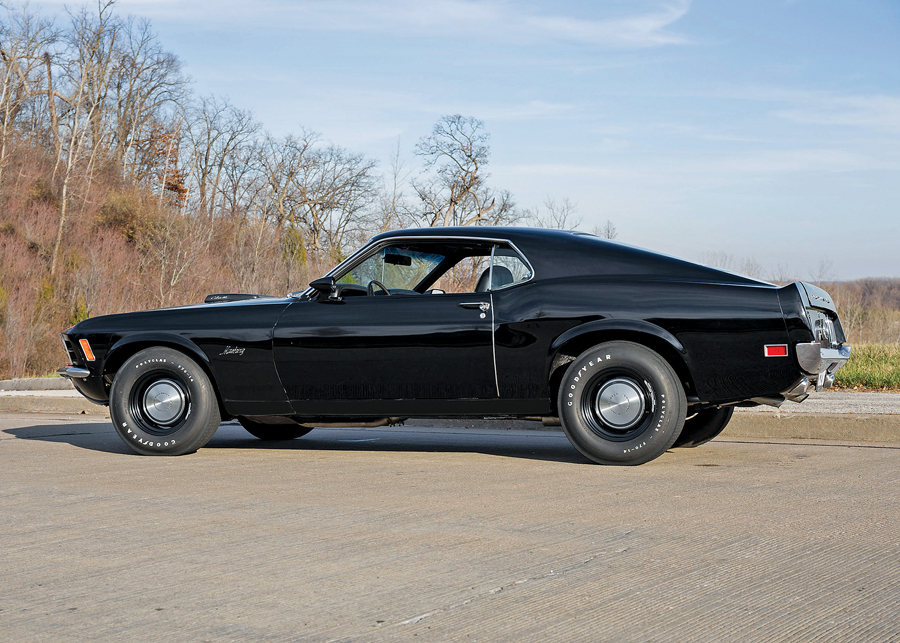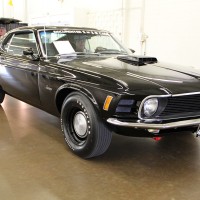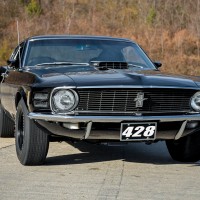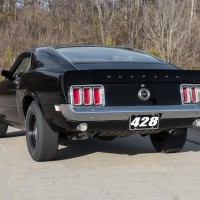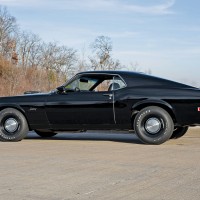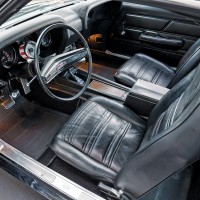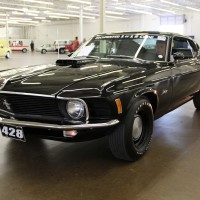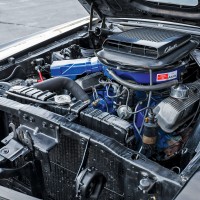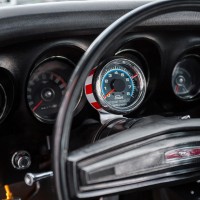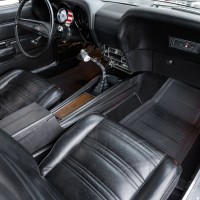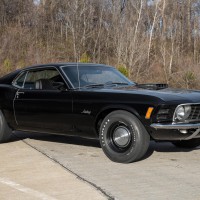- 1970 Ford Mustang R-code fastback
- 428-ci Cobra Jet V8 engine
- 4-speed manual transmission
- Complete frame-up restoration just completed
- Power disc brakes
- Steel wheels with dog-dish hubcaps
- One of one factory black/black with console R-code car
- One of four factory black/black R-code cars
- Elite Marti Report with window sticker
SCM Analysis
Detailing
| Vehicle: | 1970 Ford Mustang R-Code Fastback |
| Years Produced: | 1965–70 (fastback models) |
| Number Produced: | 45,934 (in 1970) |
| Original List Price: | $3,924 (with R-code speed options) |
| SCM Valuation: | $31,000–$46,000 |
| Tune Up Cost: | $300 |
| Distributor Caps: | $20 |
| Chassis Number Location: | VIN plate on lower left dash |
| Engine Number Location: | Above starter (part number and date code only, no VIN stamp on block) |
| Club Info: | Mustang Club of America |
| Website: | http://www.mustang.org/ |
| Alternatives: | 1970–72 Plymouth 440 ’Cuda, 1968–72 Pontiac GTO, 1967–69 Chevrolet Camaro SS 396 |
| Investment Grade: | B |
This car, Lot 2459, sold for $97,000, including buyer’s premium, at Leake’s Dallas, TX, auction on April 17, 2015. And then it wasn’t sold.
Although this car is back on the market — more on that later — it still has an interesting story.
If we dive into the evolution of the Ford Mustang, we can watch as it progressed from a nifty — and wildly popular — 4-seater coupe and convertible to an all-out street bruiser with the introduction of the pinnacle Boss 429.
The Mustang was the first Pony Car, and Ford caught the top brass at General Motors and Chrysler with their assembly lines down when the first Mustang rolled off the factory floor on March 9, 1964.
The new Mustang would go viral — long before the Internet, Snapchat, Twitter and Instagram were twinkles in programmers’ eyes — by old-fashioned word-of-mouth and Mad Men-created television commercials which debuted simultaneously on all three networks at 9:30 p.m. (for you younger readers, we only had three television networks back then).
Ford sold over 22,000 Mustangs on the very first day they arrived on the showroom floors. Sales just sped up from there, with dealers peddling 263,434 units by the end of 1964.
A Texas chicken farmer takes notice
In 1965, Ford asked Carroll Shelby to transform the Mustang into something very special — a car that more people could afford than his side-winding Cobras. The Cobra was, after all, totally impractical as an everyday driver.
The new Mustang coupe gave Shelby a chassis to tinker with, but it wasn’t until the beautifully designed fastback model debuted that the 1965 Shelby Mustang would be born.
Ford’s Mustang was sporty and could now be ordered with the punchy K-code 289-ci, 271-hp engine — and even a GT package — but gearheads gravitated to the Shelby model if they wanted the hottest car on the street (or track).
Mr. Ford wants more of the action
As the Mustang continued to trend forward with added engine choices and a body that continued to keep up with the times, so did team Shelby.
Buyers continued to plop down large sums of cash for the tweaked drivetrains, suspension upgrades and muscular styling Shelby offered. By 1967, the bean counters at Ford took a closer look at the bottom line. After all, Ford was building the cars that were supplied to Shelby. Ford engineers thought they could capture more of the high-performance market by stepping up their game with the sporty Mustang platform. That said, by 1968 the Ford Motor Company had nearly taken over the Shelby model, and most Shelby purists consider the 1967 Shelby Mustang as the last “true” Shelby Mustang.
Enter the 1969 Mach 1
The Shelby Mustang continued to be sold through 1970.
However, by 1968, Ford designers in Dearborn were busy stealing out of the Shelby playbook. By adding a few faux intake air vents, a new “shaker” hood option, rear wing, hood pins, hood and rocker graphics and some inboard driving lights, they transformed the somewhat ordinary sportroof (aka fastback) Mustang into a high-performance street car with a plethora of engine options. They called it the Mach 1.
The all-new 1969 Mach 1 took off in dealer showrooms. Performance-hungry buyers were lining up to stick their hands in the muscle car toy box, and all of the Big Three were now fully engaged in the race for more horsepower, more engine options, more stripes, hood scoops and tire-smoking fun. As the options list grew, so did the price tag.
Still, even a decked-out Mach 1 would sell for far less than a Shelby, and buyers quickly learned that you could get all the performance you wanted for less. That dynamic put the last nail in the coffin for the 1969/1970 Shelbys. Savvy buyers knew which boxes to check.
The subtle, street-smoking sleeper
Most guys in the late 1960s and early 1970s wanted a performance car to look like one — meaning that they wanted cool wheels, racing stripes, hood scoops and the upgraded badge on the fender. But some buyers simply wanted a tactical street car. They cared only about performance — not impressing the girls at the Biff Burger on a Saturday night.
Everyone knew that plenty of Mopars cruising the boulevards were absolute street killers in accountant’s clothing. The same went for COPO Camaros that looked like 6-cylinder Plain-Janes, with very little badging to reveal the deep-breathing monster lurking underneath the hood.
Ford buyers could follow the same game plan. They just ordered a Mustang without all the bells and whistles — but also checked the boxes for a full lunchbox of goodies that would smoke a decked-out SS 350 Camaro.
Even better, by 1970 the Mach 1 Mustang had ditched the faux side scoops and inboard headlights. The GT package was no longer available. So, a guy wanting to build a street sleeper in Mustang clothing could order a rather ordinary Mustang with all the nasty, stealthy performance he wanted.
It’s not a Mach 1
Our subject car is not one of the aforementioned Mach 1s. It’s not even a GT (which was not available in 1970). The original buyer of this Mustang simply wanted to go fast — and probably in a straight line. While he didn’t order the top engine package, he did order the car with the stout R-code 428 Cobra Jet (instead of the top-tier Super Cobra Jet) and the close-ratio 4-speed transmission.
He also added power front disc brakes (better than a parachute), a center console and the wide Goodyear tires. Other than that, the options list was slim, and the grand total, when sold new, came to $3,924.70.
Sure, it’s rare, but is it super valuable?
By the Marti Report, the car is one of one as-built. While that fact is interesting, it really doesn’t stack up much more value.
The one-of-one factor for our Mustang is because the car has a center console. Still, not many were ordered in black either, as the report shows that only 10 R-code cars — sans the Mach 1 package — were ever built. Given all this, our subject car is a rare build, but some of the same factors that applied 45 years ago may apply today — although inversely.
Because this car is much rarer than a Mach 1 these days, it’s also now more expensive than a Mach 1 these days.
Plenty of buyers for our subject car would likely rather own a similarly equipped Mach 1 — but with a drag-pack rear axle option — and it will cost them far less to get there. Mach 1 cars were more expensive back in the day compared with a sleeper build, but now they’re cheaper.
A rare sleeper
I’ve seen other 1969 and 1970 Plain-Jane sleeper Mustangs sell for less, and for more than a comparably equipped Mach 1, but most of them have been GTs (1969).
Finding Mustangs like our subject car is incredibly rare, as most buyers drove off the lot with a Mach 1. That said, this one is most certainly rare, but the overall package lacks some of the visual sizzle you’d expect for a big-dollar muscle car. However, it certainly is sinister-looking in black with the shaker hood and the police-style hubcaps, which adds to the weapons-grade appeal. It’s a base-model muscle car “look” that is rather revered today, and this one was ordered out of the factory that way.
From a condition standpoint, this is a great car. The paint was reported to be superb, and the overall restoration is at the highest level. As reported, the car was finished about 10 days prior to being sold at the Leake auction, so it’s as fresh as you’ll ever find.
It appears that all aspects of the car are top-notch, and that includes the chassis.
Comps are thin on the ground, as we need to compare other non-Mach 1s and GTs with at least a Q-code 428 (the entry-level 428 in 1969 and 1970) to even come close to a like-kind transaction. That’s not going to be easy. By the books, a very well-done R-code Mach 1 will chime in at about $65,000 to $95,000 in comparable condition. But a matched-up Mach 1 will be somewhat plentiful — and this car isn’t a Mach 1.
The SCM Platinum Auction Database shows only one comp that even comes close, but it’s a 1969 GT with the 428 under the hood (SCM# 227233). That car sold for $88,000 at Barrett-Jackson’s Reno auction on August 8, 2013. Otherwise, all of our comps will be Mach 1s, which are far more common than a special-order 1970 “sleeper style” Mustang.
It is hard to determine whether the car was initially well bought or sold based on past sales. We know the sale unraveled after the auction. I do know that (as of press time) the car is listed as sale pending at a well-known Midwest classic car dealer with a listing price of $124,995. While the final sale price at the dealership is confidential, I do believe that the high bid achieved at Leake’s sale was just about spot-on given the additional buyer’s premium, which would have ratcheted the total up to a crisp $97,000.
By my playbook, anything over $100,000 would be considered well sold, and under that figure a reasonably fair deal for both the buyer and seller, given the rarity and quality of the restoration. ♦
(Introductory description courtesy of Leake Auction Co.)
